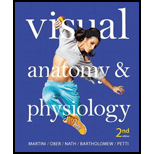
Visual Anatomy & Physiology & MasteringA&P with Pearson eText -- Valuepack Access Card -- for Visual Anatomy & Physiology & Brief Atlas of the Human Body, A Package
1st Edition
ISBN: 9780133904413
Author: Frederic H. Martini, William C. Ober, Judi L. Nath, Edwin F. Bartholomew, Kevin F. Petti
Publisher: PEARSON
expand_more
expand_more
format_list_bulleted
Question
Chapter 13.1, Problem 24SR
Summary Introduction
Introduction: The brain comprises four regions namely the cerebrum, brainstem, cerebellum, and diencephalon. The diencephalon acts as a structural as well as functional linkage between the cerebral hemisphere and the remaining central nervous system. It comprises the thalamus, hypothalamus, and epithalamus.
Expert Solution & Answer
Want to see the full answer?
Check out a sample textbook solution
Students have asked these similar questions
Explain about the Diencephalon ?
State the function and location of Corpora quadrigemina.
Describe the locations and basic functions of the limbic system and the reticular formation.
Chapter 13 Solutions
Visual Anatomy & Physiology & MasteringA&P with Pearson eText -- Valuepack Access Card -- for Visual Anatomy & Physiology & Brief Atlas of the Human Body, A Package
Ch. 13.1 - Prob. 1.1RCh. 13.1 - Prob. 1.2RCh. 13.1 - Prob. 1.3RCh. 13.1 - Prob. 2.1RCh. 13.1 - Prob. 2.2RCh. 13.1 - Prob. 2.3RCh. 13.1 - Prob. 3.1RCh. 13.1 - Prob. 3.2RCh. 13.1 - Prob. 3.3RCh. 13.1 - Prob. 4.1R
Ch. 13.1 - Which medulla oblongata components relay somatic...Ch. 13.1 - Prob. 4.3RCh. 13.1 - Prob. 5.1RCh. 13.1 - Prob. 5.2RCh. 13.1 - Prob. 5.3RCh. 13.1 - Prob. 6.1RCh. 13.1 - Prob. 6.2RCh. 13.1 - Prob. 6.3RCh. 13.1 - Prob. 7.1RCh. 13.1 - Prob. 7.2RCh. 13.1 - Prob. 7.3RCh. 13.1 - Prob. 8.1RCh. 13.1 - Prob. 8.2RCh. 13.1 - Prob. 8.3RCh. 13.1 - Prob. 9.1RCh. 13.1 - Prob. 9.2RCh. 13.1 - Prob. 9.3RCh. 13.1 - Prob. 10.1RCh. 13.1 - Prob. 10.2RCh. 13.1 - Prob. 10.3RCh. 13.1 - Prob. 11.1RCh. 13.1 - Prob. 11.2RCh. 13.1 - Prob. 11.3RCh. 13.1 - Prob. 12.1RCh. 13.1 - Prob. 12.2RCh. 13.1 - Prob. 12.3RCh. 13.1 - Prob. 13.1RCh. 13.1 - Prob. 13.2RCh. 13.1 - Prob. 13.3RCh. 13.1 - Identify the cranial nerves by name and number.
Ch. 13.1 - Prob. 14.2RCh. 13.1 - Prob. 14.3RCh. 13.1 - Prob. 1LOCh. 13.1 - Prob. 2LOCh. 13.1 - Prob. 3LOCh. 13.1 - Prob. 4LOCh. 13.1 - Prob. 5LOCh. 13.1 - Prob. 6LOCh. 13.1 - List the main components of the diencephalon, and...Ch. 13.1 - Prob. 8LOCh. 13.1 - Prob. 9LOCh. 13.1 - Prob. 10LOCh. 13.1 - Prob. 11LOCh. 13.1 - Prob. 12LOCh. 13.1 - Prob. 13LOCh. 13.1 - Prob. 14LOCh. 13.1 - Prob. 1SRCh. 13.1 - Prob. 2SRCh. 13.1 - Prob. 3SRCh. 13.1 - Prob. 4SRCh. 13.1 - Prob. 5SRCh. 13.1 - Prob. 6SRCh. 13.1 - Prob. 7SRCh. 13.1 - Prob. 8SRCh. 13.1 - Prob. 9SRCh. 13.1 - Prob. 10SRCh. 13.1 - Prob. 11SRCh. 13.1 - Prob. 12SRCh. 13.1 - Prob. 13SRCh. 13.1 - Prob. 14SRCh. 13.1 - Prob. 15SRCh. 13.1 - Prob. 16SRCh. 13.1 - Prob. 17SRCh. 13.1 - Prob. 18SRCh. 13.1 - Prob. 19SRCh. 13.1 - Prob. 20SRCh. 13.1 - Prob. 21SRCh. 13.1 - Prob. 22SRCh. 13.1 - Prob. 23SRCh. 13.1 - Prob. 24SRCh. 13.1 - Prob. 25SRCh. 13.1 - Prob. 26SRCh. 13.1 - Prob. 27SRCh. 13.1 - Prob. 28SRCh. 13.1 - Prob. 29SRCh. 13.2 - Prob. 1.1RCh. 13.2 - Prob. 1.2RCh. 13.2 - Prob. 1.3RCh. 13.2 - Prob. 2.1RCh. 13.2 - Prob. 2.2RCh. 13.2 - Prob. 2.3RCh. 13.2 - Prob. 3.1RCh. 13.2 - Prob. 3.2RCh. 13.2 - Prob. 3.3RCh. 13.2 - Prob. 4.1RCh. 13.2 - Prob. 4.2RCh. 13.2 - Prob. 4.3RCh. 13.2 - Prob. 5.1RCh. 13.2 - Prob. 5.2RCh. 13.2 - Prob. 5.3RCh. 13.2 - Prob. 6.1RCh. 13.2 - Prob. 6.2RCh. 13.2 - Prob. 6.3RCh. 13.2 - Prob. 7.1RCh. 13.2 - Prob. 7.2RCh. 13.2 - Prob. 7.3RCh. 13.2 - Prob. 1LOCh. 13.2 - Prob. 2LOCh. 13.2 - Prob. 3LOCh. 13.2 - Prob. 4LOCh. 13.2 - Prob. 5LOCh. 13.2 - Prob. 6LOCh. 13.2 - Prob. 7LOCh. 13.2 - Prob. 1SRCh. 13.2 - Prob. 2SRCh. 13.2 - Prob. 3SRCh. 13.2 - Prob. 4SRCh. 13.2 - Prob. 5SRCh. 13.2 - Prob. 6SRCh. 13.2 - Prob. 7SRCh. 13.2 - Prob. 9SRCh. 13.2 - Prob. 10SRCh. 13.2 - Prob. 11SRCh. 13.2 - Prob. 12SRCh. 13.2 - Prob. 13SRCh. 13.2 - Prob. 14SRCh. 13.2 - Prob. 15SRCh. 13.2 - Prob. 16SRCh. 13.2 - Prob. 17SRCh. 13.2 - Prob. 18SRCh. 13.2 - Prob. 19SRCh. 13.2 - Prob. 20SRCh. 13 - Prob. 1CRQCh. 13 - Prob. 2CRQCh. 13 - Prob. 3CRQCh. 13 - Prob. 4CRQCh. 13 - Prob. 5CRQCh. 13 - Prob. 6CRQCh. 13 - Prob. 7CRQCh. 13 - Prob. 8CRQCh. 13 - Prob. 9CRQCh. 13 - Prob. 10CRQCh. 13 - Prob. 11CRQCh. 13 - Prob. 12CRQCh. 13 - Prob. 13CRQCh. 13 - Prob. 14CRQCh. 13 - Prob. 15CRQCh. 13 - Prob. 16CRQCh. 13 - Prob. 17CRQCh. 13 - Prob. 18CRQCh. 13 - True/False: Indicate whether each statement is...Ch. 13 - Prob. 20CRQCh. 13 - Prob. 21CRQCh. 13 - Prob. 22CRQCh. 13 - Prob. 23CRQCh. 13 - Prob. 24CRQCh. 13 - Prob. 25CRQCh. 13 - Prob. 26CRQCh. 13 - Prob. 27CRQCh. 13 - Prob. 28CRQCh. 13 - Prob. 29CRQCh. 13 - Prob. 30CRQCh. 13 - Prob. 31CRQCh. 13 - Prob. 32CRQCh. 13 - Prob. 33CRQCh. 13 - Prob. 1CICh. 13 - Prob. 2CICh. 13 - Prob. 3CI
Knowledge Booster
Learn more about
Need a deep-dive on the concept behind this application? Look no further. Learn more about this topic, biology and related others by exploring similar questions and additional content below.Similar questions
Recommended textbooks for you
 Human Physiology: From Cells to Systems (MindTap ...BiologyISBN:9781285866932Author:Lauralee SherwoodPublisher:Cengage Learning
Human Physiology: From Cells to Systems (MindTap ...BiologyISBN:9781285866932Author:Lauralee SherwoodPublisher:Cengage Learning

Human Physiology: From Cells to Systems (MindTap ...
Biology
ISBN:9781285866932
Author:Lauralee Sherwood
Publisher:Cengage Learning
Nervous System - Get to know our nervous system a bit closer, how does it works? | Neurology; Author: FreeMedEducation;https://www.youtube.com/watch?v=6O-0CVAgaEM;License: Standard youtube license